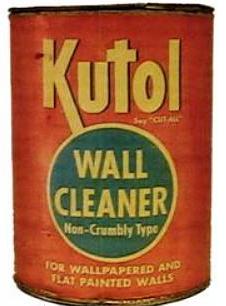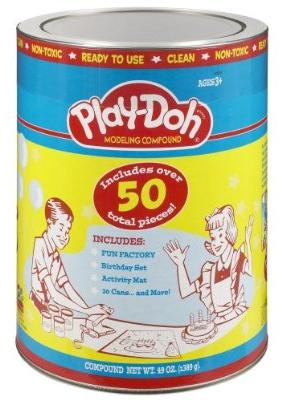Was Play-Doh Created as Wallpaper Cleaner?
Here is the latest in a series of examinations into urban legends about toys and whether they are true or false. Click here for an archive of all toy urban legends featured so far!
TOY URBAN LEGEND: Play-Doh was created as and originally produced as wallpaper cleaner!
It’s often fascinating to look back at every day life in, say, 1940, and see just how many products that were in use at the time that are not only not used today, but to describe the product today would leave people puzzled at how such a product could ever be considered a “household” product.
One such product is wallpaper cleaner.
You see, back in the days when homes were often heated by coal furnaces, the soot from the coal would cover most of the house. For most of the stuff in the house, while that was inconvenient, it was not a major deal, as you would just dust the soot off or otherwise wash it off. However, with wallpapers, you were in trouble because you could not wash it off, since it was, you know, paper. So people came up with home remedies including mixing flour, salt, water and some chemicals to roll up and down the wall to take off the soot.
Soon, companies were producing this themselves.
One such company was Kutol Products, which was a soap company out of Cincinatti that almost went under until a young man named Cleo McVicker turned it around in 1927. First, he brought his brother Noah into to run the company while he toured the country pushing their soap product. But the real turnaround came in 1933 when McVicker came up with the idea of turning the company into a discount wallpaper cleaner company.

Kutol Products wallpaper cleaner sold decently for a number of years, and the company even managed to survive McVicker’s death in 1949. His son, Joseph, joined his uncle Noah in running the company.
However, in the early 1950s, a couple of major things changed the world of wallpaper cleaner, making it the utterly obsolete product that it is today.
1. Oil and gas heat came into play, so that coal furnaces were no longer a problem.
2. Vinyl wallpaper was introduced, which took away the whole “can’t wash the wallpaper” problem.
So now Kotul Products had a product that was more or less unsellable, a point made clear during the Winter of 1954 when sales were practically nil (Winter was the time when sales were usually at their peak, with stores making their orders for the spring cleaning season). So they soon made a decision that would change their company and the world of toys forever!
As their plight was quite clear to everyone around them, Joseph’s sister-in-law, Kay Zufall, came up with an idea to help her brother-in-law’s business. Kay was a nursery school teacher and she was reading an article about homemade Christmas decorations. It occurred to her that Kotul wallpaper cleaner could be used as a clay-like substance.
She bought a can and brought it to her school and after a day of arts and crafts with the youngsters, she notified Joseph that the product could definitely work as a toy. The cleaner was non-toxic and it was specifically designed NOT to stain (unlike most clays), so all they had to do was take out the cleaning chemicals and you had a brand new type of clay!
Soon, Kutol’s Rainbow Modeling Compound (quickly renamed Play-Doh, also due to advice from Kay – wow, that lady sure helped them out a lot!) was put on the market in 1955, in the following canned format.

Joe McVicker brought it to an education convention in 1956, the same year they introduced a three-pack (of smaller cans, each one a different color), and, well, the rest is history!
So the legend is…
STATUS: True
Thanks to Tim Walsh and his excellent resource book, Timeless Toys: Classic Toys and the Playmakers Who Created Them for information. You can purchase the book at the preceding link.
Feel free (heck, I implore you!) to write in with your suggestions for future urban legends columns! My e-mail address is bcronin@legendsrevealed.com





